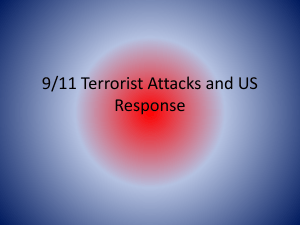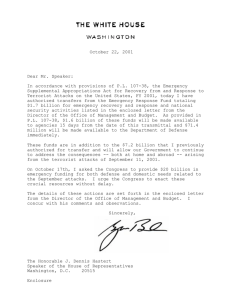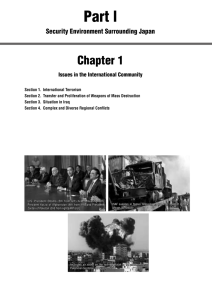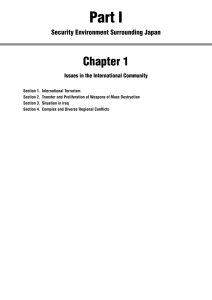Chapter 1 Issues in the International Community
advertisement
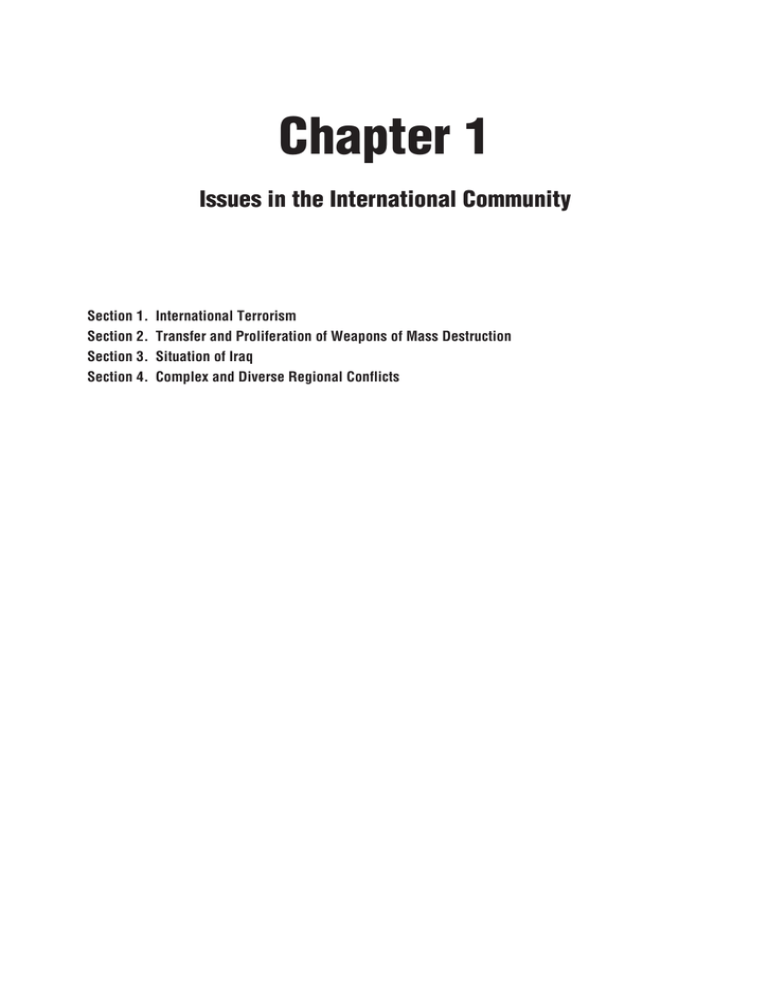
Chapter 1 Issues in the International Community Section 1. Section 2. Section 3. Section 4. International Terrorism Transfer and Proliferation of Weapons of Mass Destruction Situation of Iraq Complex and Diverse Regional Conflicts Section 1. International Terrorism 1. Overview The 9/11 attacks that took place six years ago prompted the entire world to reaffirm the threat of international terrorism, and became the spark that ignited the current fight against terrorism by the United States and other countries. In the invasion of Afghanistan launched by U.S. and U.K. forces shortly after the 9/11 attacks, many of the leaders of Al Qaeda, who had directed the 9/11 attacks, and the Taliban, who had harbored Al Qaeda, were killed or captured. However, Osama bin Laden, Mullah Mohammed Omar and remnants of their respective organizations are believed still to be hiding in the Afghanistan-Pakistan border region1, and the U.S.-led multinational forces, the International Security Assistance Force (ISAF)2, the Afghan military, and the Pakistani military are engaged in clearing operations. Countries have banded together in an international coalition, committing not only military forces but also diplomatic, law enforcement, judicial, intelligence and economic resources, but there has been no halt on acts of terrorism and terrorist plots around the world. In August 2006, for example, the U.K.’s authorities disrupted an extensive terrorist plot to blow up several in-flight passenger airplanes bound for the United States from the United Kingdom. It is reported that this attempted terror plot was possibly backed by the existence of a criminal group spanning the United Kingdom and Pakistan and Al Qaeda’s involvement. International terrorist organizations have recently been organizing cells in a more decentralized fashion, while local terrorist organizations and individuals sympathetic to their ideology have been carrying out terrorist activities on their own or in concert with these international terrorist organizations. Police investigations have revealed, for example, that the July 2005 subway and bus suicide bomb attacks in London (U.K.) were not carried out by foreign terrorists, but rather by the sons of Muslim immigrants born and raised in the U.K.3 The suicide bomb attack against a U.S. military convoy near Baghdad, Iraq, in November 2005 was also discovered to have been carried out by the Belgian wife of a Middle Eastern man. In light of the present situation, many countries in Europe and elsewhere have enacted stronger counterterrorism measures, including domestic counterterrorism laws, since the London subway and bus bomb attacks. Among the harsher steps taken by the Russian government, for instance, was the passage of a revised Counterterrorism Law in March 2006 that authorized the downing or sinking of a passenger aircraft or ship hijacked by a terrorist organization and posing the danger of loss of life or a large-scale disaster4. Counterterrorism measures are also being implemented through multinational frameworks such as the United Nations, the G8, and regional cooperation organizations. These efforts include ensuring stability and supplying recovery/reconstruction assistance to Afghanistan and Iraq, enhancing systems for exchanging counterterrorism intelligence, reinforcing international legal frameworks to sternly punish terrorists, cutting off terrorist funding and strengthening air security (including the prevention of hijacking), tightening immigration controls, adopting more effective approaches to ensure the nonproliferation of weapons of mass destruction, assisting countries with inadequate counterterrorism measures to enhance their capabilities, and taking steps to reduce or eliminate poverty, economic and social disparities and unfairness in developing countries. 2. Fight against Terrorism in and around Afghanistan The United States together with other countries has continued military operations against the Taliban and Al Qaeda in and around Afghanistan since October 2001, shortly after the 9/11 terrorist attacks. In the Arabian Sea, naval vessels from various countries have endeavored to keep these terrorists from escaping by sea and to prevent the proliferation of terrorism from Afghanistan. —8— Part I Security Environment Surrounding Japan Terrorist forces such as Taliban appear to be on the rebound since 2006, and the security situation in Afghanistan remains unstable. As the presence of the U.S.-led multinational forces, the ISAF, the Afghan military, and the police have been further strengthened in the southern and eastern areas adjacent to the border with Pakistan, the number of suicide bombings and attacks mainly targeting these multinational forces have correspondingly increased. There have been also scattered terrorist bomb attacks in Kabul, the capital of Afghanistan, and in the northern and western areas, which were relatively stable and peaceful. These circumstances impel the multinational forces and the ISAF to collaborate in large-scale military operations in the southern and eastern areas of the country. The ISAF has set up five Regional Commands under the General Headquarters in Kabul. There have 25 Provincial Reconstruction Teams (PRTs) under the Regional Commands to maintain security and conduct reconstruction assistance activities in the whole of Afghanistan. Similar activities are also continuing through the United Nations Assistance Mission in Afghanistan (UNAMA). Uzbekistan, Kazakhstan, Kirgizstan, and Tajikistan, all located in Central Asia, declared their intent to cooperate in the counter-terrorism operations conducted by the United States and its allies following the 9/11 terrorist attacks, and some of them have served as rear bases in the fight against terror by allowing the stationing of United States and other troops5. These four countries are members of the Shanghai Cooperation Organization (SCO). Within that framework, they are actively involved in activities including counterterrorism exercises of the Regional Antiterrorist Structure (RATS) set up for joint efforts to fight against terrorism. 3. Terrorist Attacks around the World Since Saddam Hussein’s regime was brought down by U.S. and U.K. military operations in 2003, it seems that terrorists have been flowing into Iraq due to degraded security and insufficient border controls, and terrorist attacks have taken place on almost a daily basis, targeting not only U.S. and other soldiers but also general Iraqi citizens and foreign civilians. In June 2006, Abu Musab Al Zarkawi, the leader of “Al Qaeda in Iraq” was killed in an air attack by multinational forces, but activities probably attributed to that organization have continued. The activities of these terrorist organizations have become a major obstacle to rebuilding Iraq. Terrorist attacks have also continued in countries near Iraq. In April 2006, a series of terrorist bomb attacks, which targeted at a supermarket and other shops in Dahab in the southern part of Egypt’s Sinai Peninsula, killed more than 20 persons. In November 2005 three Western hotels were bombed in Jordan’s capital of Amman, killing more than 50 people. Southeast Asia ranks alongside Iraq and its neighbors as an area subject to large-scale terrorist attacks. Between 2002 and 2005, Indonesia suffered large-scale terrorist attacks6. In these terrorist incidents, the involvement of Jemaah Islamiya (JI), a radical Muslim organization, is suspected. In addition to the arrests of more than 300 JI activists since 2002, the police authorities have achieved a certain level of success against JI, killing Azhari bin Husin, one of JI’s top leaders and an explosives expert, in November 2005. Since 2004, southern Thailand has also witnessed frequent attacks and bombing/arson incidents by radical Muslim separatists against facilities such as military and the police. South Asia, too, has seen frequent large-scale terrorist attacks. Terrorist bombings targeting multiple trains in city of Mumbai on India’s western coast in July 2006 killed more than 180 people. The Mumbai police authorities have announced the results of their investigation—that the attack was planned by the intelligence organs of the Pakistani military and —9— carried out by a Pakistan-based radical Muslim organization—but the Pakistani government has denied any connection with this incident. In central Sri Lanka, an October 2006 suicide terrorist bomb attack against a convey of buses carrying naval soldiers left more than 100 people dead, including civilian bystanders. The involvement of the Liberation Tigers of Tamil Eelam (LTTE), a militant secessionist Tamil organization, in this incident is suspected. (See Fig. I-1-1-1) Fig. I-1-1-1 Major Terrorism Incidents in the World (July 2006 – May 2007) * Excluding Iraq and Afghanistan Pakistan (Dargai) November 8 suicide bombing of army facilities 42 people killed, more than 20 injured India (Panipat) February 18 train bombing At least 66 people killed, dozens injured Philippines (Mindanao Island) January 10 bomb attacks At least 6 people killed, more than 20 injured India (Mumbai) July 11 train bombings At least 180 people killed, more than 700 injured — 10 — Sri Lanka (Habarana) October 16 suicide bombing At least 103 people killed, about 150 injured

